Improvising on the guitar requires you to have a good understanding of note relationships on the fretboard. The moment you need to start thinking about a particular note you want to play, it’s already too late. That’s why we study and practice scales, arpeggios, and chords. Another useful tool to visualize the relationship between notes on the fretboard are intervals.
In this lesson, you will learn about all the different musical intervals, how they look on the guitar, and how you can practice intervals so you can use them in your solos.
What Are Intervals?
An interval is the distance between two notes.
You can make a distinction between melodic intervals and harmonic intervals.
A melodic interval is when two notes sound successive.
A harmonic interval is when two notes sound simultaneous.
There are two families of intervals:
- Major intervals: 2nds (9ths), 3rds, 6ths (13ths), and 7ths.
- Perfect intervals: unisons, 4ths (11ths), 5ths, and octaves.
These two families can be adapted:
- When a major interval is lowered a half step, it becomes minor.
- When a perfect interval is lowered a half step, it becomes diminished.
- When a perfect interval is raised a half step, it becomes augmented.
Intervals on the Guitar Fretboard
1. Unison

Half steps between notes: 0
Melodic use: the repetition of a note. This is not purely theoretic though, it can be used as an effect, such as in the following example.

2. Minor Second (minor 2nd)

Half Tones: 1 (half tone = half step = 1 fret on the guitar)
Ear Mnemonic: the Jaws theme begins with a minor second
Melodic use: used all the time, in scales etc.
Harmonic use: sometimes used as an effect, as in the following example.

The minor second works well in some chords, usually with open strings:

3. Major Second (major 2nd)

Half Tones: 2 (or 1 whole tone)
Ear Mnemonic: the two first notes of Happy Birthday
Melodic use: used all the time, in scales etc.
Harmonic use: sometimes used in chords or as an effect, such as in the following example.
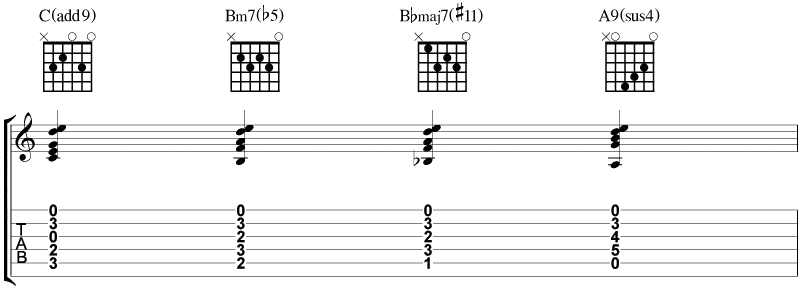
4. Minor Third (minor 3rd)

Half Tones: 3
Ear Mnemonic: the guitar riff from Whole Lotta Love (Led Zeppelin)
Melodic use: used all the time, in arpeggios, chords, …
Harmonic use: minor and major thirds are used to harmonize melodic lines (for an example see major thirds)
5. Major Third (major 3rd)

Half Tones: 4 (or 2 whole tones)
Ear Mnemonic: Oh When the Saints
Melodic use: used all the time, in arpeggios and chords.
You can also play a scale in major and minor thirds (instead of major and minor seconds).
Here’s the C major scale played in thirds:

Harmonic use: minor and major thirds can be used to harmonize melodies or as a scale for improvisation.
Here’s the C major scale harmonized in thirds:

6. Perfect Fourth (perfect 4th)

Half Tones: 5
Ear Mnemonic: Here Comes The Bride
Melodic use: just like you can play a scale in thirds, you can also play a scale in fourths (perfect and augmented fourths), such as in the following example over the C major scale:

Harmonic use: fourths are used in quartal chords, such as in So What, a popular jazz standard written by Miles Davis.
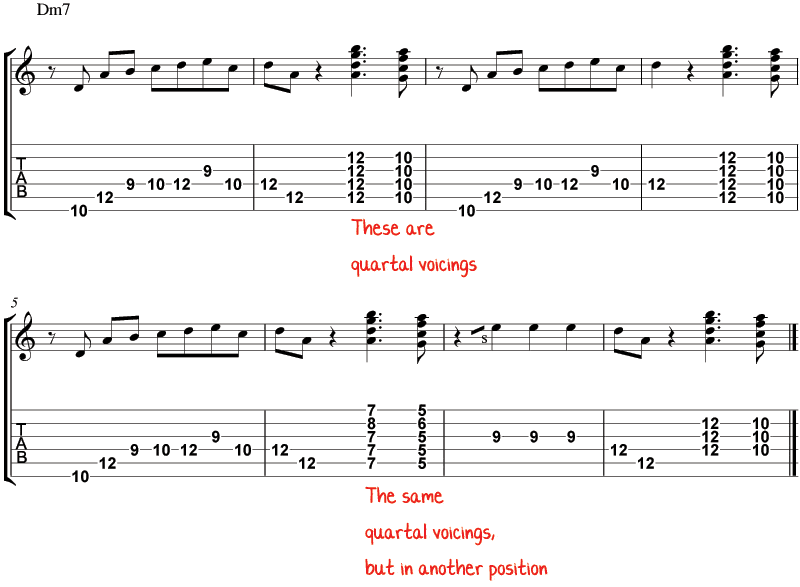
The 4th interval is also used in sus4 chords, such as in this C9sus4 chord:
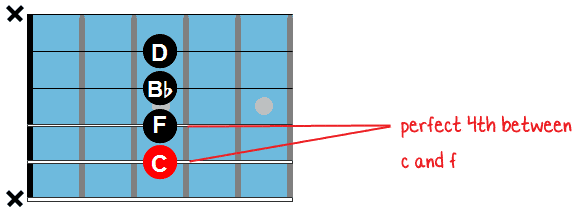
7. Augmented Fourth (aka Tritone or Diminished Fifth)
The tritone is an important interval.
It is the weakest interval, meaning that it has the tendency to go somewhere, it wants to move to other notes.
The tritone is the main interval of dissonance in our harmony and they are the reason that dominant chords and diminished chords want to move to a tonic chord.

Half tones: 6 (3 whole tones, hence the name tritone)
Ear Mnemonic: The Simpsons theme, Maria (West Side Story)
Melodic use: The tritone is an important aspect of the Locrian mode.
Harmonic use: the tritone is an important element of dominant chords, half-diminished chords and diminished 7 chords (which has 2 tritones). The tritone is also used in tritone substitution.
In the chord C7 for example, there’s a tritone between e and b flat:

8. Perfect Fifth (perfect 5th)

Half Tones: 7
Ear Mnemonic: Star Wars theme
Melodic use: you can play a scale in fifths, such as in the following example.

Pat Metheny’s song Bright Size Life starts in fifths:
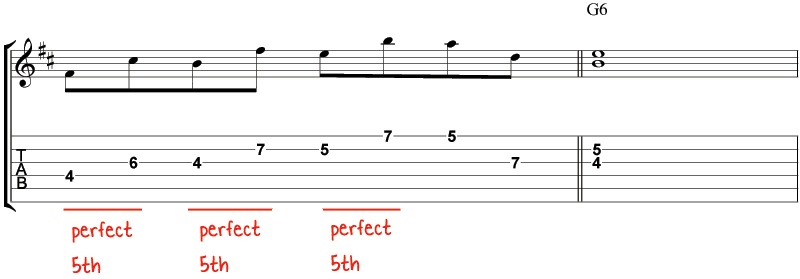
Harmonic use: the 5th is generally something you want to avoid in your jazz voicings, it does not add much to the sound. It is often used in rock though (power chords).
9. Minor Sixth (minor 6th)

Half Tones: 8 (or 4 whole tones)
Ear Mnemonic: Black Orpheus
Melodic Use: very nice interval, a bit melancholic. A scale can be played in minor and major 6ths (see major 6th)
Harmonic Use: A scale can be harmonized using minor and major 6ths (see major 6th)
There’s a minor 6th in this nice chord from the Aeolian mode (one of the guitar modes):
Dm7b6 (or Bbmaj9/D)
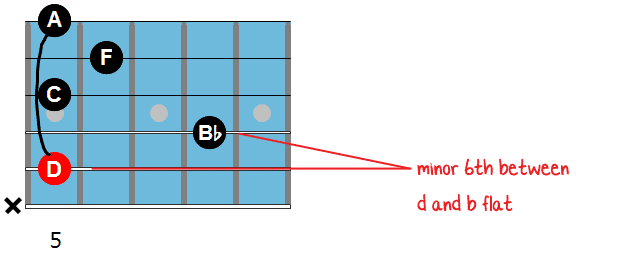
10. Major Sixth (major 6th)

Half Tones: 9
Ear Mnemonic: All Blues (Miles Davis)
Melodic Use: playing scales in major an minor 6ths sounds bluesy.
Here’s the C major scale in 6ths (grab these like little chords, let the low note ring while you play the 6th):

Harmonic Use: in the same fashion as the example above, you can harmonize a scale in 6ths:

The 6th is also an important interval in chords:
C6 (C major 6)

Cm6 (C minor 6)
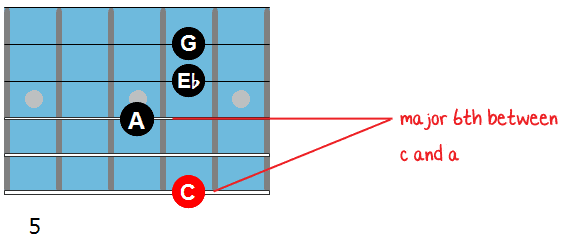
11. Minor Seventh (minor 7th)
Minor and major 7ths are important intervals in jazz. “Jazzyfying” a chord usually means adding the 7th to a triad.

Half Tones: 10 (or 5 whole tones)
Ear Mnemonic: Somewhere (West Side Story), Star Trek Theme
Harmonic use: the minor 7th is in minor 7th chords, half-diminished and dominant 7th chords.
Dm7
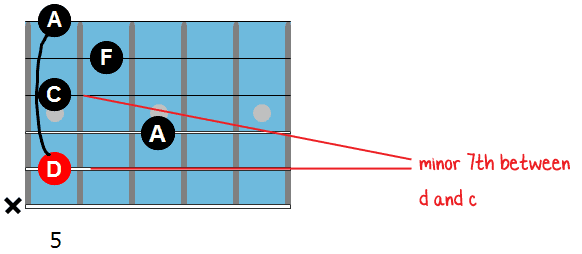
12. Major Seventh (major 7th)

Half Tones: 11
Ear Mnemonic: chorus of Take On Me (A-ha)
Harmonic use: the major 7th is a part of major 7th chords.
Cmaj7
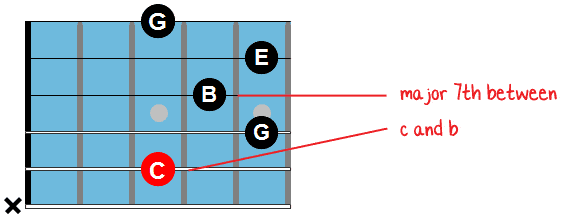
13. Perfect Octave
The circle is round, we are back at the starting note c, but 12 half tones higher.

Half Tones: 12 (or 6 whole tones)
Ear Mnemonic: Over The Rainbow
Melodic and Harmonic Use: octaves are often used à la Wes Montgomery, in solos and themes, such as in the following example from Wes Montgomery’s standard Four on Six.

Compound Intervals
The intervals we’ve seen so far are what we call “simple intervals”.
There are a couple more intervals, called “compound intervals” because they go beyond the octave.
We’re not going to talk about all of them, only the important ones.
1. Minor Ninth (minor 9th)
Interval distance: octave + minor 2nd
Use: in dominant b9 chords.
C7(b9)
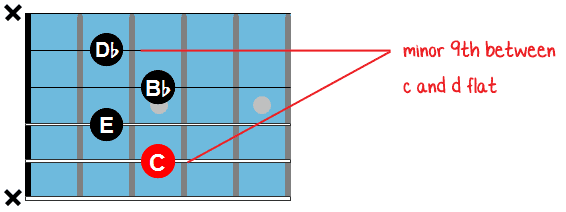
2. Major Ninth (major 9th)
Interval distance: octave + major 2nd (or 7 whole tones)
Use: in major 9, minor 9, dominant 9 chords
C9 (C dominant 9)

3. Augmented Ninth (augmented 9th)
Interval distance: octave + augmented 2nd
Use: in dominant #9 chords
C7(#9)

4. Perfect Eleventh (perfect 11th)
Interval distance: octave + perfect 4th
Use: in minor 11 chords
Am11
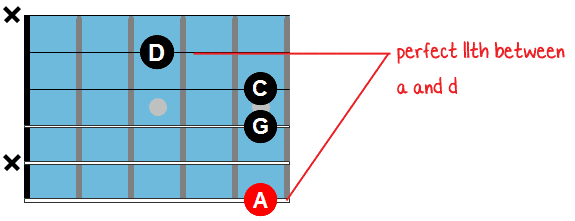
5. Augmented Eleventh (augmented 11th)
Interval distance: octave + augmented 4th
Use: in major #11 chords and dominant #11 chords
Bbmaj7#11

6. Minor Thirteenth (minor 13th)
Interval distance: octave + minor 6th
Use: in dominant b13 chords
G7b13

7. Major Thirteenth (major 13th)
Interval distance: octave + major 6th
Use: in dominant 13 chords
G13
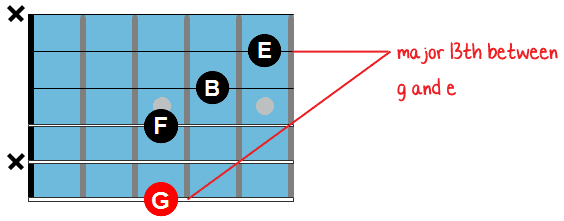
The post Guitar Intervals appeared first on Jazz Guitar Online | Free Jazz Guitar Lessons, Licks, Tips & Tricks..
from Jazz Guitar Online | Free Jazz Guitar Lessons, Licks, Tips & Tricks. https://ift.tt/2OAS7Ad
No comments:
Post a Comment